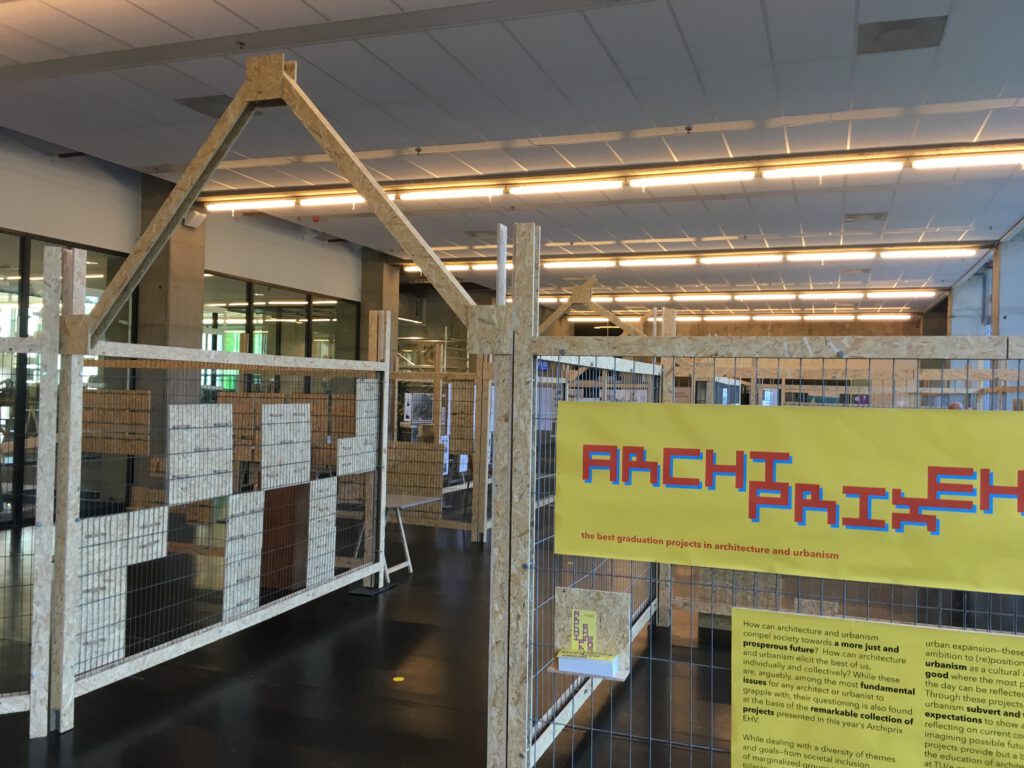Archiprix Eindhoven zonder mensen
Het belang van goed onderwijs, niemand twijfelt er aan. Maar wat is dat: goed onderwijs? Ik werk momenteel aan de vakkenstructuur en studio-opdracht van het tweede semester aan de Academie voor Architectuur in Kharkiv (Oekraïne), en zoek naar de juiste balans. In Eindhoven mocht ik vorige maand als extern jurylid van de voorselectie voor de Archiprix alle topafstudeerders van de TU Eindhoven bespreken. Een mooi moment om te vergelijken.
Vandaag sloot ik aan bij een tussenpresentatie “in Oekraïne” voor een woonproject van volwassen wezen die na hun 18e, dus na het opgroeien in het weeshuis een gezamenlijke woongroep ontwikkelen. De studenten presenteerden hun bevindingen aan zowel de bewoners als de docenten: een mooie mix van feedback om mee verder te gaan.
In Eindhoven beoordeelde ik de afstudeerprojecten, ook dit jaar weer enkele sterke stedenbouwkundige en architectonische concepten. Maar ik vond geen interviewresultaten of stakeholdergesprekken met eindgebruikers, zoals bewoners of werknemers.
Ik was niet het enige jurylid die dat opviel. Regelmatig stelden we onszelf de vraag: “De ontwerper heeft een gebruikersconcept gemaakt, maar werkt dit wel? Zit de doelgroep hier wel op te wachten?” Een interessant concept over de verdichting van de zeer diverse multiculturele woonbuurt door Georgia Castelli. Prachtige verstilde tekeningen van Marco Sironi voor een zorg-complex voor mensen met zelfmoordgedachten. Twee studentenprojecten die het verdienen om in de schijnwerpers te komen, maar waarbij ook de vraag opkwam: worden we verblind door een krachtige ruimte, zijn we verleid door een sterke conceptuele gedachte? Klopt het wel?
Deze discussie is aparte uitgelicht in het jury-rapport: “The people we build for seem absent in most of the things we do. Why not think more about facilitating processes, about the social aspect of design, about involving real people?”
Er zijn vele grote en kleine referentieprojecten waar we zien hoe veel kansen de invloed van de bewoner, ondernemer, toerist, werknemer of recreant biedt voor de ontwerper. Of het een co-housing project is in Oekraïne, bezoekersonderzoeken in een museum of een pretpark of serious gaming met jongeren over een sportpark. En natuurlijk Space-S met 400 sociale huurwoningen.
Voor ons vak en voor de studenten is het een grote meerwaarde om meer te snappen van het ontwerpen van processen en het integreren van de eindgebruikers in het ontwerpproces. Bij de faculteit Industrial Design is hier meer dan voldoende kennis over, zo zien we jaarlijks bij de afstudeertentoonstelling.
Goed onderwijs: leer de studenten denken in processen, ontwikkel interview-, workshop- en gesprekstechnieken, en verdiep de kennis over besluitvorming, governance en betrokkenheid. Niet als een extra complexiteit, maar als een versnelling, een kwalitatieve meerwaarde én een toets in het ontwerp.
Archiprix Eindhoven without people
No one doubts the importance of good education. But what is good education? At this moment, I am working on the structure and studio assignment of the second semester at the Kharkiv School of Academy (Ukraine), looking for the right balance. In Eindhoven last month, as an external jury member of the pre-selection for the Archiprix, I was able to review all the top graduates of Eindhoven University of Technology. A nice moment to compare.
Today, I joined an interim presentation “in Ukraine” for a residential project of adult orphans who develop a communal living group after the age of 18, i.e. after growing up in the orphanage. The students presented their findings to both residents and teachers: a nice mix of feedback to continue with.
In Eindhoven I assessed the graduation projects, and again this year some strong urban and architectural concepts. But I didn’t find any interview results or stakeholder discussions with end users, such as residents or employees.
I wasn’t the only member of the jury who noticed that. We regularly asked ourselves the question: “The designer has created a user concept, but does it work? Is this what the target group is waiting for? An interesting concept about the densification of the very diverse multicultural residential area by Georgia Castelli. Beautiful tranquil drawings by Marco Sironi for a care complex for people with suicidal thoughts. Two student projects that deserve to be put in the spotlight, but which also raised the question: are we blinded by a powerful space, are we seduced by a strong conceptual thought? Is it really true?
This discussion was highlighted separately in the jury report: “The people we build for seem absent in most of the things we do. Why not think more about facilitating processes, about the social aspect of design, about involving real people?”
There are many large and small reference projects where we see how many opportunities the influence of the resident, entrepreneur, tourist, employee or recreational worker offers to the designer. Whether it is a co-housing project in Ukraine, visitor research in a museum or an amusement park or serious gaming with young people about a sports park. And of course the project Space-S with 400 newly built social housing units.
For our profession and for the students it is a great added value to understand more about designing processes and to integrate the end users in the design process. At the Faculty of Industrial Design there is more than enough knowledge about this, as we see every year at the graduation exhibition.
Good education: teach students to think in terms of processes, develop interview, workshop and discussion techniques, and deepen their knowledge of decision-making, governance and involvement. Not as an extra complexity, but as an acceleration, a qualitative added value and a test in the design.


